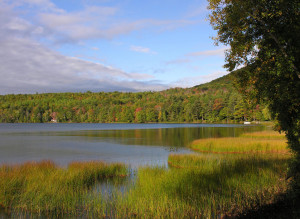Invasive Aquatic Plants Challenge Maine Lakefront Property Owners
Out and About for the Sebago Lakes Region of Maine Aug. 22 – 28
August 21, 2013Lakefront Property Owners Enjoy Hikes In and Around Woodstock, Maine
August 25, 2013Invasive Aquatic Plants Challenge Maine Lakefront Property Owners
Above Average Water Quality at Hobbs Pond in Hope, Maine
Lakefront property owners recognize that native aquatic plants are from Maine. They are essential components of healthy ecosystems in our lakes and pond–they produce oxygen, help reduce erosion and regulate nutrient cycling. These plants also provide food for birds and habitat for aquatic invertebrates and vertebrates.
Exotic plants are “from away” or non-native. While some native plants can be invasive, there are usually checks and balances, e.g. bugs that will eat them, to limit their population growth. On the other hand, invasive, non-native aquatic plants are known for their explosive growth potential because nothing will eat them. They have the ability to grow from a few plants to massive amounts that cover hundreds of acres in just a few years.
Invasive non-native aquatics are practically impossible to eradicate. They can block navigation channels, become tangled in boat motors, destroy habitat for fish and birds, and reduce the aesthetic and recreational value of our lakes. Ultimately this affects tourism, local businesses and real estate values. As the value of lakefront property erodes, taxes of non-lakefront properties increases.
Managing invasive aquatics is expensive and long term. To do so involves manual harvesting, the laying of benthic barriers or as a last resort–herbicides applied by the state.
Volunteers and professionals across Maine survey ponds for invasive aquatics. From the surface of the water, the surveyors use boats to examine the littoral zone of a lake or pond. This is the quickest method using low technology. Underwater viewing can be enhanced by using an underwater tube or simple bucket scope.
The surveyors take into consideration the following with a key to identify the plant:
Plant community–emergent? floating leaf? or submerged?
Leaf arrangement–alternate? opposite? or whorled?
Leaf shape–elliptical? blade? or oval?
Leaf edge–feather divided? toothed? or smooth?
Notes are made and photographs taken. With GPS coordinates, the location of the plant is noted. The major habitat that best describes where the plant was located is also important–in a pond or lake? in a stream or river? on a wetland? by the water’s edge? in a developed area? Sometimes, it’s even necessary to send a sample to the Maine Center for Invasive Aquatic Plants. The entire plant should never be removed.
Unlike some of the other issues facing our lakes, the one of invasive aquatic plants seems to be the hardest to predict and most difficult to manage. We can reduce phosphorus run-off by changing our practices on land. We can stop littering by changing attitudes. But . . . halting invasive aquatics is a tougher nut to crack. Once they establish colonies where they don’t belong, they’re difficult to eradicate.
You may be interested in volunteering to survey your lake or pond. Contact your lake association for more information. You may also contact the Maine Volunteer Lake Monitoring Program for more information.
To view lakefront properties for sale in Hope, Maine, click on the green box above.
To learn more about Hope lakes with their above average water quality, check out the blog links below.
Hobbs Pond, Hope, Maine: Live Your Summer Dream at Lakefront Property
Lermond Pond, Hope, Maine: Cherish Your Lakefront Vacation

